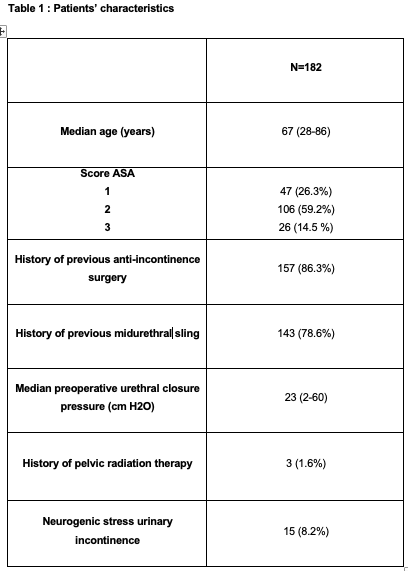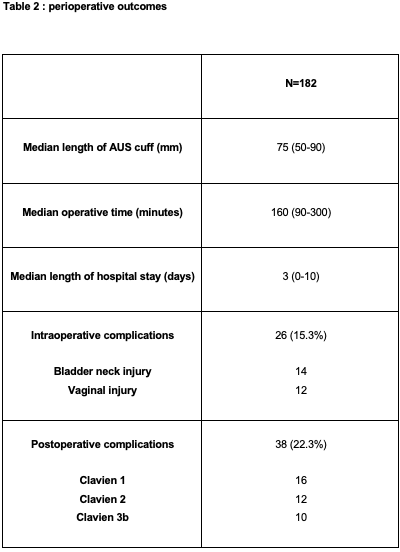Back
Poster, Podium & Video Sessions
Podium
PD34: Urodynamics/Lower Urinary Tract Dysfunction/Female Pelvic Medicine: Female Incontinence: Therapy II
PD34-06: Robot-assisted artificial urinary sphincter implantation in female patients: an international multicenter series of 182 patients
Saturday, May 14, 2022
4:20 PM – 4:30 PM
Location: Room 244
benoit peyronnet*, rennes, France, jean-nicolas cornu, rouen, France, olivier belas, Le Mans, France, Grégoire capon, bordeaux, France, xavier Biardeau, lille, France, pierre Lecoanet, Nancy, France, luis Castro-Sader, Barcelona, Spain, shahed Borojeni, paris, France, rainer hein, Magdeburg, Germany, Juliette Hascoet, rennes, France, Frederic thibault, Metz, France, Frederic Dubois, rennes, France, Vincent Cardot, paris, France, adrien vidart, suresnes, France, Aurélien descazeaud, limoges, France, Georges fournier, brest, France, frank van der aa, Leuven, Belgium
- BP
Podium Presenter(s)
Introduction: Robotic artificial urinary sphincter (AUS) implantation in women has spread significantly in several countries. However, data on robotic AUS implantation in female patients remain relatively limited. The aim of this study was to report the perioperative and functional outcomes of robotic AUS implantation in women.
Methods: All female patients who underwent robotic AUS implantation using a standardized technique (anterior approach) between 2013 and 2021 at sixteen European institutions were included in a retrospective study. The indication for AUS implantation was type III stress urinary incontinence and intrinsic sphincter deficiency defined as a combination of a low urethral closure pressure/Valsalva leak point pressure and loss of urethral mobility. The primary endpoint was the functional outcome categorized as dry (0 pads), improved or unchanged.
Results: One hundred and eighty-two patients underwent robotic AUS implantation. Patients’ characteristics are summarized in table 1. There were 26 intraoperative complications (15.6%): 14 bladder neck injuries and 12 vaginal injuries. Surgeons carried on with AUS implantation in all except one case. Thirty-eight patients experienced postoperative complications (22.3%) but only ten were Clavien =3 (5.5%). After a median follow-up of 12 months, there were 11 AUS explantations performed in total (6.1%) including 8 for urethral extrusion or vaginal exposure (4.4%). The 5-year estimated explantation-free survival was 88.8% (see figure). At the last follow-up visit, 152 patients were dry (83.5%), 15 were improved (8.2%) and 15 were unchanged (8.2%).
Conclusions: In this large international multicenter series, robotic AUS implantation was associated with promising perioperative and functional outcomes. This series confirm the reproducibility of the robotic “anterior” technique of female AUS implantation
Source of Funding: none


Methods: All female patients who underwent robotic AUS implantation using a standardized technique (anterior approach) between 2013 and 2021 at sixteen European institutions were included in a retrospective study. The indication for AUS implantation was type III stress urinary incontinence and intrinsic sphincter deficiency defined as a combination of a low urethral closure pressure/Valsalva leak point pressure and loss of urethral mobility. The primary endpoint was the functional outcome categorized as dry (0 pads), improved or unchanged.
Results: One hundred and eighty-two patients underwent robotic AUS implantation. Patients’ characteristics are summarized in table 1. There were 26 intraoperative complications (15.6%): 14 bladder neck injuries and 12 vaginal injuries. Surgeons carried on with AUS implantation in all except one case. Thirty-eight patients experienced postoperative complications (22.3%) but only ten were Clavien =3 (5.5%). After a median follow-up of 12 months, there were 11 AUS explantations performed in total (6.1%) including 8 for urethral extrusion or vaginal exposure (4.4%). The 5-year estimated explantation-free survival was 88.8% (see figure). At the last follow-up visit, 152 patients were dry (83.5%), 15 were improved (8.2%) and 15 were unchanged (8.2%).
Conclusions: In this large international multicenter series, robotic AUS implantation was associated with promising perioperative and functional outcomes. This series confirm the reproducibility of the robotic “anterior” technique of female AUS implantation
Source of Funding: none



.jpg)
.jpg)